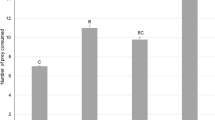Abstract
Experiments were performed to determine the effect of caterpillar feeding damage on wasp foraging behavior and to determine the relative importance of visual and olfactory plant cues for foraging wasps. In an experiment using caterpillar-damaged leaves, wasps took significantly more larvae from the previously damaged plants compared to the controls in the experiments with tobacco plants, but wasps did not distinguish between damaged and control plants in the experiments with tomato plants. Another experiment indicated that wasps use a combination of visual and olfactory cues of plant damage in their search for prey rather than just visual or olfactory cues alone. Furthermore, these results suggest that leaf shape may affect wasp detection of caterpillar feeding damage and thus detection of prey.
Similar content being viewed by others
References
Aldrich, J. R., Kochansky, J. P., and Sexton, J. D. (1985). Chemical attraction of the eastern yellow jacket,Vespula maculifrons (Hymenoptera: Vespidae).Experientia 41: 420–422.
Bergelson, J. M., and Lawton, J. H. (1988). Does foliage damage influence predation on the insect herbivores of birch?Ecology 69: 434–445.
Carter, M. C., Sutherland, D., and Dixon, A. F. G. (1984). Plant structure and the searching efficiency of coccinellid larvae.Oecologia 63: 394–397.
Dicke, M., Sabelis, M. W., Takabayashi, J., Bruin, J., and Posthumus, M. A. (1990). Plant strategies of manipulating predator-prey interactions through allelochemicals: Prospects for application in pest control.J. Chem. Ecol. 16: 3091–3118.
Duncan, C. (1939). A contribution to the biology of North American vespine wasps.Stanford Univ. Publ. Biol. Sci. 1–272.
Flint, H. M., Salter, S. S., and Walters, S. (1979). Carophyllene: An attractant for the green lacewingChrysopa carnea Stephens.Environ. Entomol. 8: 1123–1125.
Gould, W. F., and Jeanne, R. L. (1984).Polistes wasps (Hymenoptera: Vespidae) as control agents for lepidopteran cabbage pests.Environ. Entomol. 13: 150–156.
Greany, P. D., and Hagen, K. S. (1981). Prey selection. In Nordlund, D. A., Jones, R. L., and Lewis, W. J. (eds.),Semiochemicals: Their Role in Pest Control, Wiley, New York, pp. 121–135.
Grevstad, F. S., and Klepetka, B. W. (1992). The influence of plant architecture on the foraging efficiencies of a suite of ladybird beetles feeding on aphids.Oecologia 92: 399–404.
Heinrich, B. (1979). Foraging strategies of caterpillars. Leaf damage and possible predator avoidance strategies.Oecologia 42: 325–337.
Heinrich, B. (1993). How avian predators constrain caterpillar foraging. In Stamp, N. E., and Casey, T. M. (eds.),Caterpillars: Ecological and Evolutionary Constraints on Foraging, Chapman and Hall, New York, pp. 224–245.
Heinrich, B., and Collins, S. L. (1983). Caterpillar leaf damage and the game of hide-and-seek with birds.Ecology 64: 592–602.
Hirose, Y., and Takagi, M. (1980). Attraction of two species ofPolistes wasp to prey wounded by them.Appl. Entomol. Zool. 15(1): 108–110.
Jeanne, R. (1972). Social biology of the neotropical waspMischocyttarus drewseni.Bull. Mus. Comp. Zool. Harvard Univ. 144(3): 63–150.
Kareiva, P. M., and Sahakian, R. (1990). Tritrophic effects of a simple architectural mutation in pea plants.Nature 345: 433–434.
Lawson, F. R., Rabb, R. L., Guthrie, F. E., and Bowery, T. G. (1961). Studies of an integrated control system for hornworms on tobacco.J. Econ. Entomol. 54(1): 93–97.
Lederhouse, R. C. (1990). Avoiding the hunt: Primary defenses of lepidopteran caterpillars. In Evans, D. L., and Schmidt, J. O. (eds.),Insect Defenses, Adaptive Mechanisms and Strategies of Prey and Predators, SUNY Press, Albany, NY, pp. 175–189.
Litte, M. (1979).Mischocyttarus flavitarsis in Arizona: Social and nesting biology of a polistine wasp.Z. Tierpsychol. 50: 282–312.
Niemela, P., and Tuomi, J. (1987). Does the leaf morphology of some plants mimic caterpillar damage?Oikos 50: 256–257.
Obrycki, J. J. (1986). The influence of foliar pubescence on entomophagous species. In Boethel, D. J., and Eikenbary, R. D. (eds.),Interactions of Plant Resistance and Parasitoids and Predators of Insects, Ellis Horwood, Chichester, pp. 61–83.
Rasmy, A. H. (1977). Predatory efficiency and biology of the predatory mite,Amblyseius gossipi (Acarina: Phytoseiidae) as affected by plant surfaces.Entomophaga 22(4): 421–423.
Raveret Richter, M. (1988).Prey Hunting and Interactions Among Social Wasp (Hymenoptera: Vespidae) Foragers and Responses of Caterpillars to Hunting Wasps, Ph.D. dissertation, Cornell University, Ithaca, NY.
Raveret Richter, M. A., and Jeanne, R. L. (1985). Predatory behavior ofPolybia sericea (Olivier), a tropical social wasp (Hymenoptera: Vespidae).Behav. Ecol. Sociobiol. 16: 165–170.
Sokal, R. R., and Rohlf, F. J. (1981).Biometry, W. H. Freeman, New York.
Tietz, H. M. (1972).An Index to the Described Life Histories, Early Stages and Hosts of the Macrolepidoptera of the Continental United States and Canada, A. C. Allyn, Sarasota, FL, pp. 467–468.
Turlings, T. C. J., Tumlinson, J. H., and Lewis, W. J. (1990). Exploitation of herbivore-induced plant odors by host-seeking parasitic wasps.Science 250: 1251–1253.
Wood, D. L. (1982). The role of pheromones, kairomones, and allomones in the host selection and colonization behavior of bark beetles.Annu. Rev. Entomol. 27: 411–446.
Yamamoto, R. T., and Fraenkel, G. S. (1960). The specificity of the tobacco homwormProtoparce sexta (Johan.) to solanaceous plants.Ann. Entomol. Soc. Am. 53: 503–507.
Author information
Authors and Affiliations
Rights and permissions
About this article
Cite this article
Cornelius, M.L. Influence of caterpillar-feeding damage on the foraging behavior of the paper waspMischocyttarus flavitarsis (Hymenoptera: Vespidae). J Insect Behav 6, 771–781 (1993). https://doi.org/10.1007/BF01201676
Accepted:
Issue Date:
DOI: https://doi.org/10.1007/BF01201676




